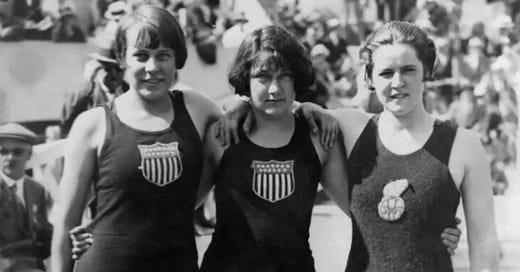Paris, you’re three times a lady: the feminine face of the Olympics
Paris is leading the way in hosting the Olympic Games ... again ...

Paris has held the Olympic Games three times throughout the history of the Games. This is the first time in Olympic history that there is gender parity – female athletes comprising fifty percent of all participants.
We all know the Lionel Ritchie song Three Times a Lady, which The Commodores first sang in 1978:
Thanks for the times that you’ve given me
The memories are all in my mind
And now that we’ve come to the end of our rainbow
There’s something I must say aloud
You’re once, twice, three times a lady
And I love you …
We’ll be singing this song at the end of the summer Olympics when we’ve come to the end of our rainbow, because this will be the third time that Paris has hosted the Olympic Games: 1900, 1924, and 2024.
Only one other country can claim a third summer Games: London (1908, 1948, and 2012).
Los Angeles will be able to claim this feat when it hosts the next Olympic Games (1932, 1984, and 2028).
The Olympics has changed a lot over the past 100 years, especially for female athletes. Then, they were almost invisible. Today, they are a visible feminine face.
On 4 May 1924, the Olympic Games commenced in Paris, returning a hundred years later, commencing on 26 July 2024.
In 1924, there were 17 sports and 126 events. In 2024, there will be 32 sports and 329 events.
In 1924 there were 3 demonstration events: Basque pelota (like tennis, hitting the ball with one hand), savate (French kickboxing or footfighting), and canoeing. Canoeing became an Olympic sport in 1936 and has remained in the Games ever since. In 2024, the four demonstration events include: cane fighting (martial arts), breaking (breakdancing or dance-sport), skateboarding, sport climbing, and surfing. Skateboarding, sport climbing, and surfing were first introduced as demonstration events in the 2020 Olympics.
Four years after the introduction of the first Olympic Games of the modern era in 1896, women first competed at the Olympics in Paris in 1900 in 5 events: croquet, equestrian, golf, sailing, and tennis. In 1900, there were 1,226 athletes: 1,204 (98%) men and 22 (2%) women.
In 1924, there were 3,089 athletes: 2,954 (96%) men and 135 (4%) women. In 2024, there will be 10,500 athletes: 5,250 (50%) men and 5,250 (50%) women. This will be the first time that there is gender parity at the Olympics.
In 1924, the outstanding female athlete was American swimmer Gertrude Ederle (1905-2003), winning 1 Gold and 2 Bronze Olympic medals. She won gold in the 4x100 metres freestyle relay, bronze in the 100 metres individual freestyle, and bronze in the 400 metres individual freestyle. In the relay, her team players were Euphrasia Donnelly, Ethel Lackie, and Mariechen Wehselau. Two years later, on 6 August 1926, Gertrude became the first woman to swim across the English Channel. Her time was 14 hours and 34 minutes. Only five men had swum across the Channel before her, with the best time of 16 hours and 33 minutes by Enrique Tirabocchi.
Also a star in Paris in 1924 was American tennis player Hazel Virginia Wightman (1886-1974), winning 2 Olympic gold medals. She opted not to play singles tennis. Instead, she entered, and won, the ladies doubles and the mixed doubles. In the ladies double, she partnered Helen Wills, and in the mixed doubles, she partnered Dick Williams.
In 1924, Finnish runner Paavo Nurmi won 5 gold medals: 1,500 metres individual, 3,000 metres (team), 5,000 metres (individual), individual cross country, and team cross country. He had 55 minutes rest from the end of the 1,500 metres race before he started the 3,000 metres race. He wanted to compete in the 10,000 metre event, an event he had competed in 17 times during his career and never lost. The Finnish officials refused to enter him in the race.
In 2024, who will reign supreme?
To end, let’s look at the mottos of the Paris Olympic Games. The official motto of the International Olympic Committee (IOC) was first adopted in 1924.
1900: None
1924: Citius, Altius, Fortius – Faster, Higher, Stronger
2024: Ouvrons grand les Jeux – Games Wide Open
Look at the Paris 2024 Olympic Games logo. It is representative of the Olympic torch. Look again – it has a feminine face. It represents gender parity. The woman is Marianne, the national symbol of the Republic of France since the French Revolution (1789-1799), the Age of Enlightenment. She embodies the motto of France which first appeared during the Revolution and was written into the French Constitution in 1958: Liberté, Egalité, Fraternité – Liberty, Equality, Fraternity.
MY PARIS WEBSITE AND ALL THINGS PARISIAN
Can’t see the whole article? Want to view the original article? Want to view more articles? Go to Martina’s Substack: The Stories in You and Me






